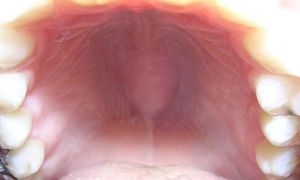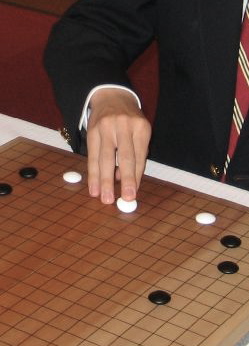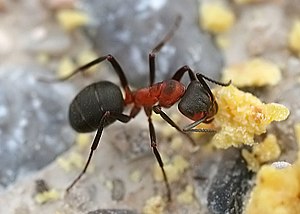Korean/Words/Hotspots
Appearance
가다
[edit | edit source]
- Comparatives
|
가르다
[edit | edit source]

- Relatives
|
갈래
[edit | edit source]- Relatives
- 가르다 (gareuda, "to split, divide")
- 가람 (garam, "river")
- 가래 (garae, "spade")
- 가리비 (garibi, "scallop")
- 갈기 (galgi, "shred, strip; mane")
- 갈비 (galbi, "rib")
- 갈퀴 (galkwi, "rake") [8]
- 갈퀴다 (galkwida, "to rake") [9]
- 할퀴다 (halkwida, "to scratch") [10]
- Comparatives
- The galley (ship) looks like a long extension of the Chinese pictogram 非, which is modelled after a pair of opposing wings of a bird. cf. Japanese ガレー (gare). See: w:jp: ガレー船

- The galley (kitchen), as seen in large airplanes or ships, also looks like a long extension of the Chinese pictogram 非 more often than not. cf. Japanese ギャレー (gyare). See: w:jp: ギャレー
Galley (kitchen). The left is of a cruise ship, and the right of the Royal Navy during World War II.
- The galley (for proofreading) is simply derived from a long array of typeset trays prior to the final pagination. cf. Japanese ゲラ (gera). See: w:jp: ゲラ刷り

- The long gallery is used for displaying art collections, and so on.

거흠
[edit | edit source]


- Synonyms
- 입천장 (ib-cheonjang, "palate, roof of the mouth") cf. Sino-Korean 구개 (口蓋, gugae) [16]
- 웃거흠 (ut-, obsolete "upper jaw") [17]
- 입웃거흠 (ib-ut-, obsolete "upper jaw") [18]
- 위턱 (wi-teog, "upper jaw") cf. Sino-Korean 상악 (上顎, sang-ag)
- Relatives
- 아래턱 (arae-teog, "lower jaw") cf. Sino-Korean 하악 (下顎, ha-ag)
- 턱 (teog, "jaw, chin")
- 턱뼈 (teog-ppyeo, "jawbone, mandible")
- 잇몸 (it-mom, "gum, flesh around teeth")
- 구무 (gumu, obsolete "hole, cavity")
- Comparatives
|
- Revision of wikt: 거흠
|
구무
[edit | edit source]- Alternative forms
- 구멍 [gumeong] cf. German Gaumen
- 구메 [gume] cf. Low German gume, Middle Dutch gumme
- 구모 [gumo] cf. Old High German goumo
- Compounds
- 귓구무 [gwit-] earhole
- 입구무 [ip-] oral cavity
- 콧구무 [kot-] nostril
- Comparatives
- gum #English ("the flesh around the teeth")
- Gaumen #German ("palate, or the roof of the mouth; oral cavity") [25]
- gumme #Middle Dutch ("palate")
- gōma #Old English ("palate")
- goumo #Old High German ("palate")
- クマ #Japanese (kuma, "bear 熊; cove, cavity 隈") [26]
구르다
[edit | edit source]

- Relatives
- Comparatives
|
|
- くるま #Japanese (kuruma, "car, wheel" )
- ごろごろ, ゴロゴロ (gorogoro)
- (onomatopoeia) with the sound of thunder
- (onomatopoeia) with a rumble
- (onomatopoeia) with a growl
- (onomatopoeia) with a purr
- (onomatopoeia) rolling
- (onomatopoeia) ubiquitously
- (onomatopoeia) idly passing the time [33]
누나
[edit | edit source]
- 같은 부모에게서 태어난 사이거나 일가친척 가운데 항렬이 같은 사이에서, 남자가 손위 여자를 이르거나 부르는 말. 때로는 남남끼리 나이가 적은 남자가 손위 여자를 정답게 이르거나 부르는 말. 예: 옆집 누나.
- older sister of a male (by extension applied to close, friendly older females)
- Relatives
- Comparatives
|
도
[edit | edit source]- 이미 어떤 것이 포함되고 그 위에 더함의 뜻을 나타내는 보조사.
- too, as well; either ... or, (negative) neither ... nor
- Comparatives
|
돌멘
[edit | edit source]
- Related terms
- 고인돌 (goindol, "dolmen"), origin unknown.
- *돌면 (돌宀, dolmyeon, "dolmen"), assumed.
- 면 (宀, myeon, Old Chinese *men, "roof; house"). [48]
두
[edit | edit source]
- Nominal form
- 둘 (dul)
- Relatives
|
- Comparatives
|
두다
[edit | edit source]
- Relatives
- 놓다 (noh-da, "to lay down, put down")
- Compounds
- 놓아두다 (noh-a-, "to get something laid down")
- 쌓아두다 (ssah-a-, "to get something piled")
- 바둑을 두다 (badug-eul-, "to play go game," lit. "to place one after another stone in the vital position on the board.") [53]
- Comparatives
|
|
둑
[edit | edit source]

- Design high water level (HWL)
- Low water channel
- Flood channel
- Riverside slope
- Riverside banquette
- Levee crown
- Landside slope
- Landside banquette
- Berm
- Low water revetment
- Riverside land
- Levee
- Protected lowland
- River zone

- 높은 길을 내려고 쌓은 언덕. 하천이나 호수의 물, 바닷물의 범람을 막기 위하여 설치하는, 흙이나 콘크리트 따위로 만든 구축물. 보를 만들거나 논밭을 보호할 목적으로 쌓은 언덕.
- dyke, levee, bank, embankment, dam [57]
- Comparatives
- dyke as "barrier to prevent flooding"
|
|
- WHY & HOW it is vital
- Wikipedia: Yu the Great #Great Yu controls the waters (大禹, c. 2123–2025 BC)
- From: Wikipedia: Great Flood (China)
- He figures prominently in the Chinese legend of "Great Yu Who Controlled the Waters" (Chinese: 大禹治水; pinyin: Dà Yǔ Zhì Shuǐ).
- Still in 2020 summer, we saw such a disastrous flooding along the Yangtze River.
- The readers do miss the story of such a thrilling success he made by controlling the huge body of water that he may well be called the father of flood control, or 한물(hanmur, "flood") + 아비(abi, "father") in Korean wordplay.
- Korean dictionaries
|
- See also
둔
[edit | edit source]
- Synonyms
- Compounds
- 둔병 (-byeong, lit. "dun soldiers")
- 둔전 (-jeon, lit. "dun farm")
- Relatives
- 둔덕 (dun-deog, "hill")
- 둔치 (dun-chi, "dune")
- 둔치다 (dunchi-da, "to camp, station")
- 진치다 (dunchi-da, "to camp, station")
- Comparatives
|
| 둔 (dun) [66] | 둑 (duk) [67] | ||||||||||||||||||||||||||||||||||||
|---|---|---|---|---|---|---|---|---|---|---|---|---|---|---|---|---|---|---|---|---|---|---|---|---|---|---|---|---|---|---|---|---|---|---|---|---|---|
|
|
딛다
[edit | edit source]또
[edit | edit source]- See: #도
- [부사] 어떤 일이 거듭하여.
- [부사] 그 밖에 더.
- [부사] 그럼에도 불구하고.
또한
[edit | edit source]- See: #도
- [부사] 어떤 것을 전제로 하고 그것과 같게.
- [부사] 그 위에 더. 또는 거기에다 더.
만들다
[edit | edit source]
- Roman: mandeul-da
- Older: 믱글다 (mving-gvl-da)
- Verb [74]
- See also
- 만지다 (manjida, "to handle, manage")
말
[edit | edit source]
The Tower of Babel narrative in Genesis 11:1–9 is an origin myth meant to explain why the world's peoples speak different languages. [76] Nevertheless,
God confused no language;
people have made so many!
- 사람의 생각이나 느낌 따위를 표현하고 전달하는 데 쓰는 음성 기호. 곧 사람의 생각이나 느낌 따위를 목구멍을 통하여 조직적으로 나타내는 소리를 가리킨다. [79]
- language, speech
- Compounds
- Comparatives
|
- See also
- 뜻 (tteut, "meaning; intention; significance")
말개미
[edit | edit source]

- Roman: mal-gaemi
- Noun [83]
- Synonyms
- Relatives
- 개미 (gaemi, "ant")
- Comparatives
|
- See also
말거머리
[edit | edit source]
- Roman: mal-geomeori
- Noun [93]
- Relatives
- 거머리 (geomeori, "leech")
- Comparatives
|
| ||||
- See also
- 말- (mal, "horse; large, coarse")
말벌
[edit | edit source]
- Roman: mal-beol
- Noun [102]
- Relatives
- 벌 (beol, "bee")
- Comparatives
|
말파리
[edit | edit source]
|
머구리
[edit | edit source]- Synonyms
- Relativs
- 메구리 [112] (meguri, "frog" (Jeonbuk dialect))
- 메구리1 [113] (meguri, "frog" (Pyeongan & Hamgyeong dialect))
- 메구리2 [114] (meguri, "frogman" (Hambuk dialect))
- Comparatives
미리내
[edit | edit source]- Synonyms
- 은하 (eunha, lit. "silvery river")
- 은하수 (eunhasu, lit. "silvery river waters")
- Relatives
- Comparatives
- 天河 #Japanese (てんが, tenga, "Milky Way," lit. "Sky River")
버텅아래
[edit | edit source]RR: beoteong-arae
- Your, His or Her Majesty
- Synonyms
- Comparatives
- Majesty
- The common majesty is "the quality of being impressive and great." What could physically justify the royal Majesty? It may be especially when His/Her Majesty leads the great noble crowd. Likewise is the case with the Korean counterpart, which is a metonym from Korean 버텅 (beoteong, "stepstone" + 아래 (arae, "the lower part"), possibly a calque from Sino-Korean 폐하 (pyaeha) from Chinese 陛下, all suggesting the noble gathering below the royal stepstone. As such, great nobility, east and west, must act as a measure, metaphor and/or metonym for great royalty and/or majesty.
- Comments
- This entry is to enter 표준국어대사전 (pyojun-gukeo-daesajeon), too.
치우
[edit | edit source]
- Roman: chiu
- Hanja: 蚩尤
- Comparatives
- See also
- Tuesday, meaning "Tiw's day"
- Thing, the ancient Germanic assembly
- Mars Thingsus in Latin, meaning "Mars
or the war god characteristicof the Thing" - Tinghus in Norwegian, meaning "Courthouse", literally, "Thing-house" cf. Korean/Words/텽집
태극
[edit | edit source]- RR: taegeuk (太極) [122]
- The Ultimate Oneness, Taiji, or the like. [123]
- 태극기
- RR: taegeukgi (太極旗)
-
The 1882 flag of Korea (since 1949 the flag of South Korea).
-
The national flag of the Republic of Korea (2011-present).
- 태극도
- RR: taegeukdo (太極圖)
- Taijitu or yin-yang diagram
-
Fuxi 'Earlier Heaven' bagua arrangement.
- Comments
- It is quite an irony as well as mystery that the colorful shield pattern above (ca. AD 430) of an Western Roman infantry unit is the earliest known Taijitu or yin-yang diagram, most likely of East Asian origin, and that most likely earlier than that. The influence of the East on the West would have never ended with that!
- See also
-
The Möbius band symbolizes a unity or oneness [129]
-
To turn a rectangle into a Möbius strip [130]
텽
[edit | edit source]
- Noun
- 한옥에서, 몸채의 방과 방 사이에 있는 큰 마루. [134]
- the large hall between rooms in Korean housing.
- Meanwhile
- Relatives
- 텽집 (tyeongjip) [136] [137]
- 청사 (cheongsa), 廳舍 (tīngshe) [138]
- 청당 (廳堂, cheongdang),[139] 廳堂/厅堂 (tīngtáng) [140]
- 청문 (聽聞) [141] [142] [143]
- 청문회 (聽聞會) [144]
- Comparatives
Note: The relation of 텽 (廳, tyeong, "government office") to 텽집 (廳집, tyeongjip, "government office builing") is at least analogous to that of þing#Icelandic ("parliament") to þinghús#Icelandic ("parliament house"). | |||||
- References
- https://en.wikipedia.org/wiki/Thing_(assembly)
- https://no.wikipedia.org/wiki/Ting_(forsamling)
- https://no.wikipedia.org/wiki/Tinghus
- https://sv.wikipedia.org/wiki/Tingshus
- https://en.wikipedia.org/wiki/Husting
- https://en.wikipedia.org/wiki/Courthouse
- https://ko.wikipedia.org/wiki/팅그
- Footnotes
품다
[edit | edit source]- Roman: pumda
- Verb [153]
- 괴어 있는 물을 계속해서 많이 푸다.
- Relatives
- 푸다 (puda, "to dip, draw, ladle" (not frequentative))
- 파다 (pada, "to dig")
- 뿜다 (ppumda, "to spout, spurt, blow, cf. fume)
- 용두레 (yongdure) [154]
- Comparatives
|
해바라기
[edit | edit source]
- 국화과의 한해살이풀. 높이는 2미터 정도이며, 잎은 어긋나고 넓은 달걀 모양인데 가장자리에 굵은 톱니가 있다. 8~9월에 노란색의 큰 두상화(頭狀花)가 줄기 끝이나 가지 끝에 피고 열매는 수과(瘦果)를 맺는다. 씨는 기름을 짜서 등유로 쓰거나 식용하고 줄기 속은 이뇨, 진해, 지혈에 약재로 쓴다. 관상용이고 중앙아메리카가 원산지로 세계 각지에 분포한다.
- Synonyms
- 향일화 (向日花, hyang-il-hwa)
- Relatives
- 해 (hae, "sun") from 희 (hvi, "white; sun")
- 바라보다 (bara-boda, "to look (forward) to")
- 바라다 (barada, "to desire, want")
- 보다 (boda, "to see, look at")
- Comparatives
- The following translations center around the sun.
|
햇귀
[edit | edit source]

(きょくじつき, Kyokujitsu-ki)
The Rising Sun Flag
- RR: haetgwi [157]
- the rising sun's rays, literally, sun's ear. [158]
- Derivatives
- 햇귀엣골 or 해귀엣골 (haegwietgol, "the halo of the sun")
- Comparatives
- https://en.wiktionary.org/wiki/wheel#Etymology, focusing on Old English hwēogol that seems to relate to Korean 해의 고리 (haeui gori, "the sun's ring or halo").
햇물
[edit | edit source]- RR: haetmul [159]
- Synonyms
- Compares
- German Himmel ("sky")
References
[edit | edit source]- ↑ https://ko.dict.naver.com/#/search?query=가다
- ↑ https://en.wiktionary.org/wiki/가다
- ↑
- ↑ https://ko.dict.naver.com/#/search?query=가르다
- ↑ https://en.wiktionary.org/wiki/가르다
- ↑ https://ko.dict.naver.com/#/search?query=갈래
- ↑ https://en.wiktionary.org/wiki/갈래
- ↑ Compare:
- hark #Dutch "rake"
- Harke #German "rake"
- ↑ Compare:
- harken #Dutch "to rake"
- harken #English "to listen, hear, regard"
- harken #German "to rake"
- ↑ 손톱이나 날카로운 물건으로 긁어 상처를 내다.
- A set of fingernails may well serve as a rake.
- ↑ Illustration from Brockhaus and Efron Encyclopedic Dictionary (1890—1907)
- ↑ https://ko.dict.naver.com/#/search?query=거훔
- ↑ https://ko.dict.naver.com/#/search?query=거흠
- ↑ https://en.wiktionary.org/wiki/거흠
- ↑ This sense of gum is a result of semantic change from the original "palate".
- ↑ Equal to Chinese 上顎 (shàng'è), 口蓋 (kǒugài), 齶 (è) "palate, roof of mouth"
- ↑ Together with the Chinese counterpart 上顎, this makes sense of "palate, roof of the mouth" at last.
- ↑ This is the most precise and least concise. Korean 웃거흠 is more precise and less concise than Korean 거흠.
- ↑
(derived from Old English goma, Old High German goumo "palate")Revision as of 05:39, 9 October 2007 (edit) (undo) (thank)
Visviva (talk | contribs) - ↑ https://ko.dict.naver.com/#/search?query=구무
- ↑ https://en.wiktionary.org/wiki/구무
- ↑ (obsolete) hole, hollow, cavity
- ↑ (obsolete) vulva
- ↑ 남광우 편저. 교학 고어사전. 교학사. 1977. p. 140.
- ↑ While obsoleting this sense, German Gaumen below mainly means "palate" nowadays. Perhaps it may have begun with "oral cavity" (possibly together with "palate") and ended with "palate" alone anyway at last.
- ↑ https://ja.wikipedia.org/wiki/クマザサ (kumazasa)
- なお、「熊笹」という表記もよく見受けられるが、ほとんどは「隈笹」の誤字である。しかし、健康食品の中には、熊の絵を描いたり、熊の出るような深山の笹などと称して「熊笹」としているものもある(その「熊笹」が「隈笹」と同一かは、健康食品のパッケージの表記では普通わからない)。
- ↑ https://ko.dict.naver.com/#/search?query=구르다
- ↑ https://en.wiktionary.org/wiki/구르다
- ↑ cf. 굴리다
- 바퀴처럼 돌면서 옮겨 가게 하다. ‘구르다’의 사동사.
- ↑ cycle (n.) https://www.etymonline.com/word/cycle#etymonline_v_521
- ↑ Cf. Japanese reduplication ゴロゴロ (gorogoro) below
- ↑ Note the unclear transitive vs. intransitive forms in European languages.
- ↑ Cf. Korean counterparts:
- 그러구러 (geureo-gureo): "그럭저럭 시간이 흐르는 모양."
- 그럭저럭 (geureog-jeoreog): "그렇게 저렇게 하는 사이에 어느덧."
- ↑ Benedictine nuns of the Mariendonk Abbey, Grefath, Düsseldorf, Germany.
- ↑ What a coincidence it is that all wear glasses!
- ↑ https://ko.dict.naver.com/#/search?query=누나
- ↑ https://en.wiktionary.org/wiki/누나
- ↑ Synonyms:
- ↑ Synonyms:
- ↑ https://www.websters1913.com/words/Nun
- Nun (?), n. [OE. nunne, AS. nunne, fr. L. nonna nun, nonnus monk; cf. Gr. ?, ?; of unknown origin. Cf. Nunnery.]
- ↑ Synonyms:
- ↑ https://ko.dict.naver.com/#/search?query=도
- ↑ https://en.wiktionary.org/wiki/도
- ↑ Listen to the audio there!
- ↑ https://ko.dict.naver.com/#/search?query=돌멘
- ↑ https://en.wiktionary.org/wiki/돌멘
- ↑ A dolmen, a prehistoric megalith having a capstone supported by two or more upright stones.
- ↑ 宀 #Japanese
On: べん (ben), めん (men)
Kun: やね (yane, "roof"), いえ (ie, "house"). - ↑ https://ko.dict.naver.com/#/search?query=두
- ↑ https://en.wiktionary.org/wiki/두
- ↑ https://ko.dict.naver.com/#/search?query=두다
- ↑ https://en.wiktionary.org/wiki/두다
- ↑ One theory about the etymology of 바둑 (badug) is that it was known as 바독 (badog), a diminutive of 바닥 (badag, "base"), hence the go board. Another is that either 바둑 or 바독 or the dialect 바돌 (badol) means 바둑돌 (badug-dol, "go stone"), which fits the opening phrase well.
- ↑ https://www.websters1913.com/words/Do
- Do (d?), v. t. or auxiliary. [...]
1. To place; to put. [Obs.] Tale of a Usurer (about 1330).
2. To cause; to make; -- with an infinitive. [Obs.]
- Do (d?), v. t. or auxiliary. [...]
- ↑ https://ko.dict.naver.com/#/search?query=둑
- ↑ https://en.wiktionary.org/wiki/둑
- ↑ Compare Korean/Words/담 as well as wikt: dam.
- ↑ cf. dike #English, ditch #English
- ↑ American English.
- ↑ Levee #
- A levee (/ˈlɛvi/), dike, dyke, embankment, floodbank or stopbank is an elongated naturally occurring ridge or artificially constructed fill or wall that regulates water levels.
- ↑ You might wonder why this should come first.
- ↑ https://ko.dict.naver.com/#/search?query=둔
- ↑ https://en.wiktionary.org/wiki/둔
- ↑ This definition is necessary but too insufficient.
- ↑ https://ko.dict.naver.com/#/search?query=진 군사들의 대오(隊伍)를 배치한 것. 또는 그 대오가 있는 곳.
- ↑ A thinly-topped or obtusely-topping heap or hill, say, dune. It may further compare with English down, town, dun, etc., and with the other Germanic relatives.
- ↑ A thickly-topped or acutely-topping heap or hill, say, dyke. It may further compare with English tight, thigh, dough, etc., and with their Dutch and German (or Yiddish) counterparts.
- ↑ "Soft, fluffy immature feathers which grow on young birds"
- ↑ dun #Danish, dun #Norwegian, dun #Swedish, dúnn #Icelandic.
- ↑ "garden"
- ↑ "fence"
- ↑ Yiddish dikh
- ↑ "After the boat capsized, I thought that I would never set foot on dry land again."
- ↑ https://ko.dict.naver.com/#/search?query=만들다
- ↑ by Pieter Bruegel the Elder (1563)
- ↑ According to the story, a united human race in the generations following the Great Flood, speaking a single language and migrating eastward, comes to the land of Shinar. There they agree to build a city and a tower tall enough to reach heaven. God, observing their city and tower, confounds their speech so that they can no longer understand each other, and scatters them around the world.
- ↑ https://en.wiktionary.org/wiki/말
- ↑ https://en.wiktionary.org/wiki/말씀
- ↑ https://ko.dict.naver.com/#/search?query=말씀
- ↑ 말 (mal, "language") + 뜻 (tteut, "meaning")
- ↑ https://ko.dict.naver.com/#/search?query=말뜻
- 말이 가지는 뜻이나 속내.
- ↑ ... Old English māl (“speech, contract, agreement, lawsuit, terms, bargaining”), from Old Norse mál (“agreement, speech, lawsuit”); related to Old English mæðel (“meeting, council”), mæl (“speech”) ...
- ↑ 말 (mal, "horse") + 개미 (gaemi, "ant")
- ↑ https://ko.dict.naver.com/#/search?query=말개미
- ↑ https://en.wiktionary.org/wiki/말개미
- ↑ 그러면, 거꾸로, 왕개미는 일상적인 ‘말개미’를 고답적으로 또는 학술적으로 이르는 말인가?
- ↑ However, you may not like its Korean calque or loan translation 홍개미 that must be 말개미 in Korean context!
- ↑ 개밋과의 곤충. 몸의 길이는 7~13mm이며, 검은색 또는 갈색이고 금빛 털이 빽빽하게 나 있다. 일개미의 머리는 타원형인데 수컷의 머리는 둥글다. 한국, 일본 등지에 분포한다.
- ↑ 개밋과의 곤충. 일개미의 몸의 길이는 8mm 정도이며 붉은 갈색이고, 배는 어두운 갈색이다. 암컷은 머리와 가슴이 검은 갈색이고 꽁지는 붉은 갈색이다. 한국, 유럽, 일본, 중국 등지에 분포한다.
- ↑ This looks like a loan translation of Formica rufa.
- ↑ Maybe it began with "horse ant"(馬蟻) and ended with simply "ant"(螞蟻), as 馬("horse") corrupted into 螞("insect").
- ↑ "Horse ant (Zoöl.), a large ant (Formica rufa); -- called also horse emmet."
- ↑ 말 (mal, "horse") + 거머리 (geomeori, "leech")
- ↑ https://ko.dict.naver.com/#/search?query=말거머리
- ↑ https://en.wiktionary.org/wiki/말거머리
- ↑
- ↑ Created by User:KYPark, 22 February 2013
- ↑ All the original {{t}} templates were made {{t-}} but for Finnish {{t+}} by Rukhabot, 2 April 2013.
- ↑ Added by User: Atitarev, 26 February 2013
- ↑ Added by User:Wyang, 22 February 2013
- ↑ Uniquely related to "water buffalo" rather than "horse"
- ↑ 말 (mal, "horse") + 벌 (beol, "bee")
- ↑ https://ko.dict.naver.com/#/search?query=말벌
- ↑ https://en.wiktionary.org/wiki/말벌
- ↑ Or *horse-bee, as it is much bigger than common bees.
- ↑ Etymology: Probably a calque of Chinese 馬蜂 (mǎfēng).
- ↑ cf. Pferdeameise ("horse ant"), Pferdebremse ("horse fly"), Pferdeegel ("horse leech"), Pferdefliege ("horse fly").
- ↑ " Pferdebremse 여성 [동물] 등에의 일종, 말파리"
- ↑ https://ko.dict.naver.com/#/search?query=머구리
- ↑ https://en.wiktionary.org/wiki/머구리
- ↑ This has overridden the titled 머구리 (meoguri) entirely nowadays. Such was not the case, but rather the opposite, in old days.
- ↑ '개구리'의 방언(전북)
- ↑ '개구리1'의 방언(평안, 함경)
- ↑ '잠수부(潛水夫)'의 방언(함북)
- ↑ https://ko.dict.naver.com/#/search?query=미리내
- ↑
- 폐하 1 陛下
- 황제나 황후에 대한 경칭.
- 폐하 2 陛下
- 뜰의 층계 아래.
- ↑ Mandarin (Pinyin): Chīyóu
- ↑ "The ancient Germanic god of war, identified with Tyr of Norse mythology. Possibly the god after whom Tuesday was named."
- ↑ Týr is the relevant Wikipedia page.
- ↑ "(Norse mythology) The Norse god of war, identifiable with Tiu or Tiw."
- ↑ "Týr is the namesake of the Tiwaz rune (ᛏ), a letter of the runic alphabet corresponding to the Latin letter T. By way of the process of interpretatio germanica, the deity is the namesake of Tuesday ('Týr's day') in Germanic languages, including English. Interpretatio romana, in which Romans interpreted other gods as forms of their own, generally renders the god as Mars, the ancient Roman war god, and it is through that lens that most Latin references to the god occur. For example, the god may be referenced as Mars Thingsus (Latin 'Mars of the Thing') on 3rd century Latin inscription, reflecting a strong association with the Germanic thing, a legislative body among the ancient Germanic peoples."
- ↑
- ↑ 표준국어대사전
- 중국 철학에서, 우주 만물의 근원이 되는 실체.
- 하늘과 땅이 분리되기 이전의 세상 만물의 원시 상태.
- ↑ 표준국어대사전
- 대한민국의 국기. 흰 바탕의 한가운데 진홍빛 양(陽)과 푸른빛 음(陰)의 태극을 두고, 사방 대각선 상에 검은빛 사괘(四卦)를 둔다. 사괘의 위치는 건(乾)을 왼편 위, 곤(坤)을 오른편 아래, 감(坎)을 오른편 위, 이(離)를 왼편 아래로 한다. 조선 고종 19년(1882)에 일본에 수신사로 간 박영효가 처음 사용하고, 고종 20년(1883)에 정식으로 국기로 채택ㆍ공포되었다. 1949년에 문교부 고시로 현재의 형태로 확정되었다.
- ↑ That shows the shield pattern of the Western Roman infantry unit armigeri defensores seniores.
- ↑ It shows a taijitu in red and black, with the motto contraria sunt complementa ("opposites are complementary").
- ↑ Numericana - Escutcheons of Science
- ↑ That is, the yin-yang diagram, "with black representing yin and white representing yang. It is a symbol that reflects the inescapably intertwined duality of all things in nature, a common theme in Taoism. No quality is independent of its opposite, nor so pure that it does not contain its opposite in a diminished form: these concepts are depicted by the vague division between black and white, the flowing boundary between the two, and the smaller circles within the large regions."
- ↑ Of binary opposition, that is, Taiji of yin and yang.
- ↑ Join the edges labelled A so that the directions of the arrows match.
- ↑ Cf. Mandarin: 厅 (ting)
- ↑ Simplified: 厅 (ting) "hall, large room"
Shinjitai: 庁 (chō)
Definitions: hall; large room. - ↑ 한자사전: 廳
- 관청(官廳), 관아(官衙)
- government office
- 마루, 대청(大廳: 방과 방 사이에 있는 큰 마루)
- large hall
- 관청(官廳), 관아(官衙)
- ↑ 한글사전: 청9 廳
- ↑ 금성판 활용옥편 p.289.
- ↑ 남광우 편저, 교학고어사전, 1997. p.1350.
텽 [명] 청(廳), 대청(大廳)
텽집 [명] 청(廳), 대청(大廳) - ↑ The old Sino-Korean 텽 (廳, tyeong) alone is too ambiguous to do without such a compound as 텽집 (廳집, tyeongjip) prototypical of the modern 청사 (廳舍, cheongsa).
- ↑ (Taiwan, historical) government office; government building (under Japanese rule)
- ↑ https://ko.dict.naver.com/#/search?query=청당
‘관청’의 북한어. - ↑
- hall (for holding meetings, concerts, receiving guests, etc.)
- department in a large government organization (such as a ministry); office
- government department at a provincial level
- ↑ 들을 청(聽)
들을 문(聞) - ↑ w:National Assembly hearing
- ↑ https://en.wiktionary.org/wiki/hearing
- (uncountable) A proceeding at which discussions are heard.
- There will be a public hearing to discuss the new traffic light.
- (uncountable) A proceeding at which discussions are heard.
- ↑ https://ko.dict.naver.com/#/search?query=청문회
어떤 문제에 대하여 내용을 듣고 그에 대하여 물어보는 모임. 주로 국가 기관에서 입법 및 행정상의 결정을 내리기에 앞서 이해관계인이나 제삼자의 의견을 듣기 위하여 연다. - ↑ cf. tinghus
- ↑ cf. Thingstead
- ↑ cf. tinghus
- ↑ cf. þinghús
- ↑ cf. tinghus
- ↑ cf. þingstede
- ↑ cf. þinghús
- ↑ cf. tingshus
- ↑ https://ko.dict.naver.com/#/search?query=품다
- ↑
- 낮은 곳의 물을 높은 곳의 논이나 밭으로 퍼 올리는 데 쓰는 농기구.
- a long bucket to pump or draw water up to a higher field
- 낮은 곳의 물을 높은 곳의 논이나 밭으로 퍼 올리는 데 쓰는 농기구.
- ↑ https://ko.dict.naver.com/#/search?query=해바라기
- ↑ https://en.wiktionary.org/wiki/해바라기
- ↑ 햇귀
- ↑ 표준국어대사전 정의
- 해가 처음 솟을 때의 빛.
- =햇발(사방으로 뻗친 햇살).
- ↑
-
- [haetmul] > [haemmul], which is easier to pronounce.
-
- ↑
- =햇무리(햇빛이 대기 속의 수증기에 비치어 해의 둘레에 둥글게 나타나는 빛깔이 있는 테두리).






![The earliest known Taijitu or yin-yang diagram. [125]](http://upload.wikimedia.org/wikipedia/commons/thumb/2/28/Armigeri_defensores_seniores_shield_pattern.svg/120px-Armigeri_defensores_seniores_shield_pattern.svg.png)
![Coat of arms adopted by Niels Bohr in 1947 [126] [127]](http://upload.wikimedia.org/wikipedia/commons/thumb/d/da/Coat_of_Arms_of_Niels_Bohr.svg/81px-Coat_of_Arms_of_Niels_Bohr.svg.png)
![Taijitu (太極圖) [128]](http://upload.wikimedia.org/wikipedia/commons/thumb/3/3c/Yin_and_Yang_symbol.svg/120px-Yin_and_Yang_symbol.svg.png)


![The Möbius band symbolizes a unity or oneness [129]](http://upload.wikimedia.org/wikipedia/commons/thumb/7/71/Moebius_Surface_1_Display_Small.png/120px-Moebius_Surface_1_Display_Small.png)
![To turn a rectangle into a Möbius strip [130]](http://upload.wikimedia.org/wikipedia/commons/thumb/6/6e/M%C3%B6biusStripAsSquare.svg/113px-M%C3%B6biusStripAsSquare.svg.png)